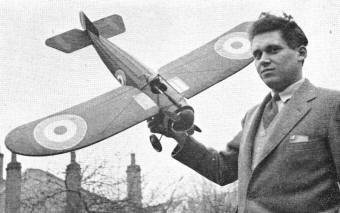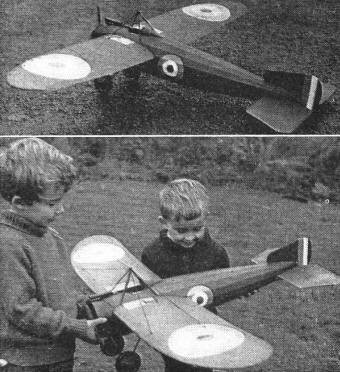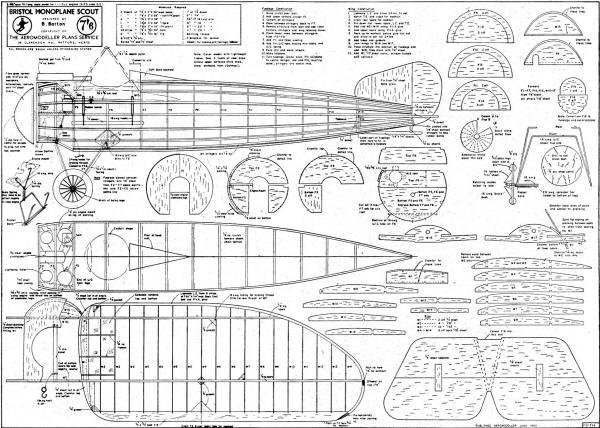|
Although originally
designed and built for free flight, this fairly large scale mode of the Bristol
Scout monoplane could easily be adapted for control line or radio control flying.
With a wingspan of 46 inches and a robust airframe, it can withstand the rigors
of aerobatic flight. Replacing the glow fuel engine with a modern brushless motor
and LiPo batteries helps keep the vibration and therefore wear and tear to a minimum,
and also avoids getting messy fuel all over your nice airplane. It would also allow
you to lighten the airframe a bit to reduce the wing loading. Seeing the younger
boy looking in awe at the airplane reminds me of how I would have regarded it at
that age if given the opportunity even to hold it. Since these plans
are no longer available, you can click the one presented below to get the full resolution
version. It was only one page wide, so it is a bit fuzzy.
Bristol Monoplane Scout

Designer with his Davies-Charlton Spitfire powered prototype
in picture opposite shows off the realistic transparent wing panels and single gun.
Model is a slow flier, very easy to build with scale stringers and rib positions.
Specifically designed for easy yet true to scale construction, this one-eighth
scale fighter from W.W.I. by Brian Barton is ideal for 1cc to 1.5cc.
A typical example of British procedure for dealing with a new and advanced type
of aircraft that will outclass all others, was displayed in 1917 when R.F.C. squadrons
were eagerly awaiting delivery of the Bristol Monoplane Scout in France. The Monoplane,
first flown in 1916, then having a maximum speed of 132 m.p.h., with a 110 h.p.
Le Rhone rotary engine, was highly manoeuvrable and very aerodynamically clean for
its time. These features of the aircraft were altered very little in the production
version and the design appeared promising especially to the pilots in France who
had "got wind" of the aircraft's performance. But despite this the Monoplane was
only ordered in small numbers and did not even see service in France on the Western
Front, but was relegated to duties in the Middle East that did not warrant an aircraft
of such quality. Many reasons have been given as to why the Monoplane was rejected
for use on the Western Front, one being that the ban imposed on monoplanes in 1912,
was still present in the minds of some when the type was considered for acceptance
into the R.F.C. (The ban was imposed after a number of accidents involving structural
failure with Morane Monoplanes, and was never quite forgotten until the Spitfire
and Hurricane had flown and were proved safe and successful). The official reason,
however, was that the landing speed was too high (at 49 m.p.h.!) This in turn was
thought to have been created to hide the unwanted publicity that a certain high
ranking officer obtained through his lack of skill, resulting in the crashing of
one of the Monoplane prototypes. Knowing we British, this may well have been the
reason!
The service that the Bristol Monoplane did see, in the Middle East, was in Mesopotamia
in the hands of 72 Squadron, and in Macedonia with 17 and 47 Squadrons, A few were
also sent out to Palestine, but other than the capture of the towns of Kifri and
Kirkuk from the Turks in May 1918, the Bristol Monoplane Scout did not contribute
greatly towards the success of the Allies in the First World War, and after the
War had ended, what appeared to be a most successful single seat scout aircraft
and by some, was thought would gain complete air supremacy for Britain, disappeared
unnoticed from the service scene.

At right, a ground shot illustrates the realism of stringers
on circular section fuselage while designer's family play their part in recovery
after a flight
Our model, scaled down to one-eighth size (in keeping with many of our other
W.W.I subjects) from 30 ft. 10 ins. to 46 ins. span incorporates
all the details of the full-size, such as scale ribs, stringers, Vickers gun and
downward vision panels at the wing roots.
The aim was to obtain a realistic model with relatively light weight construction
methods to reduce wing loading and so get true scale appearance in the air. Stringers
on the fuselage are disposed to obtain correct effect, and with the muffled note
of the 1 c.c. or 1.5 c.c. engine behind that large spinner, the Bristol Monoplane
is as near as one can get to being a perfect replica of the full size. Flying speed
is slow, and stability such that it will recover from any dud launch or gust upset.
It is also remarkably easy to build. Designer Brian Barton is one of the most
prolific model builders of our acquaintance, and likes building so much that he
is continually engaged in making ranges of Astro Hogs, Smog Hogs and the like for
lazy radio control flyers. So when he wanted to create this scale model for his
own flying enjoyment, he sensibly applied his accumulated experience of kits and
plans from all countries to produce a building system that almost qualifies for
beginner status. Moreover, it is quick construction, and abbreviated stage by stage
information is included on the plan.
The multi-stringered circular section fuselage is built around a horizontal crutch,
first made over the plan view. By applying half-formers and lining up with master
stringers, the torpedo like fuselage is soon taking shape. Cowling is not at all
involved, and the only part likely to bog down the novice is the large spinner.
While it might not be a scale model any longer, the Bristol Monoplane could very
well be flown without the spinner if need be.
Wings are one-piece with ingenious seating on the fuselage for knocking-off in
the event of a crash, and the transparent sections for pilot downward visibility
add to the appearance of centre section weakness although in fact the wing is very
strong. Cabane and bracing over the wing are dummy only, not contributing to strength.
All tail surfaces are sheet, and inset stiffeners in the tailplane prevent warping.
What could be more simple? Wing tip washout and the flat bottomed airfoil are non-scale
aids to model stability, permitting a wide centre of gravity position tolerance
although the ideal balance point is that shown on the plan.
Coloured olive drab on the upper surfaces and buff on the undersides, with the
roundels outlined in white, the Monoplane can fly on a scale prop diameter of 12
inches, even with only 1 c.c. power. The Davies-Charlton Spitfire used on the prototype
was turning very slowly indeed; but nevertheless most surely with so large a fan
when on test flights. For the man who wants his realism to come without too much
effort we cannot think of a more suitable choice than this World War I subject.

Bristol Monoplane Scout
Plans
Full size copies of this 1/7th scale reproduction are available price 8s. Including
post from plans service, quote plan FSP 759 when ordering.
Notice:
The AMA Plans Service offers a
full-size version of many of the plans show here at a very reasonable cost. They
will scale the plans any size for you. It is always best to buy printed plans because
my scanner versions often have distortions that can cause parts to fit poorly. Purchasing
plans also help to support the operation of the
Academy of Model Aeronautics - the #1
advocate for model aviation throughout the world. If the AMA no longer has this
plan on file, I will be glad to send you my higher resolution version.
Try my Scale Calculator for
Model Airplane Plans.
Posted February 11, 2023
(updated from original
post on 12/13/2014)
|